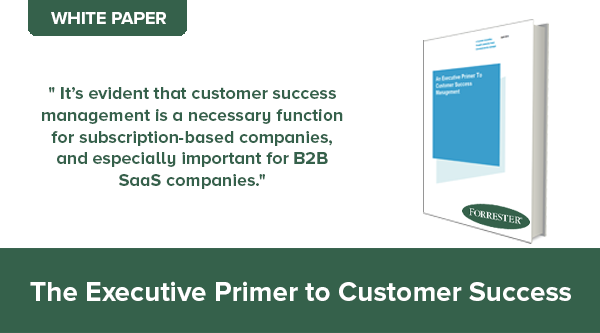There’s been a ton of conversation in the past several years about the technology buying power shift from the CIO to the CMO. The arguments supporting this claim are that a) marketing has the budget, b) SaaS has expedited application time to value and c) organizationally, marketers are building “full stack” teams that can handle basic web and database development without requiring an IT bottleneck.
While CIOs and CMOs argue this issue online and offline, there’s an even greater influence lurking on the sidelines: customer success.
Now let me be clear, I’m not advocating that marketing will one-day roll up to the Chief Customer Officer (although I know a few CCO’s who could build a case there). My thesis is that the customer success movement has changed the way marketers think about acquiring, nurturing and promoting customers. There’s no longer any glory in building your logo wall unless there’s an evangelist and referral engine behind each one.
Quite simply, customer success is the key ingredient to long-term business growth and profitability. By 2015, marketers will be discussing customer-centric marketing more than any other buzzword in the industry.
It sounds noble – I mean, in theory, what marketing team would not acknowledge a focus on customers as a driver to their success? However in practice, customer-centric marketing means a whole lot more than understanding your ideal customer profile.
It means nurturing your existing customers to drive renewals and up-sell revenue. We read in Box’s recent S1 filing that the company drove a 136% retention rate in 2014. They aren’t the only ones experiencing triple-digit retention numbers. In fact, its been shown that companies who can drive a 2% increase in retention can generate a 20% higher multiple (more on that here).
These numbers tell us that building a marketing program around customer success is arguably more profitable than acquisition programs for mature businesses. In fact, the data shows that it’s a 5x more cost-effective use of your time.
Marketers can use the wealth of data available on their customers to tailor programs that build intimacy, deliver value and drive towards up-sell. One example is to monitor product usage in order to understand how customers are interacting with the product – identifying opportunities to nurture based on which features are under-utilized. You can trigger a “how-to” email series on that specific area where training is needed most.
It means turning customers into advocates and creating new revenue streams. Every sales deck in the world has a logo slide (also, affectionately known as a “NASCAR slide”). In the old world, that very logo was the only advocacy tactic that marketers used to acquire new customers. Sure the occasional reference call or case study would be agreed to – but finding willing customers far enough along in their lifecycle with your product was a difficult task.
Today, the use of customer logos is considered somewhat of table stakes. This is especially true of products with freemium models where any employee in the world could register for a service, oftentimes without IT approval.
What if behind every logo was an evangelical “advocate,” who not only increases spend with your company year-on-year, but also refers net new business to your sales team? That reality is here, and companies like Influitive are developing technology to create an advocate culture within customer marketing teams.
Advocacy goes far beyond a simple reference call, but filling out a rating or review within a marketplace, engaging with your social media activity, or even writing a blog post or speaking at your conference. Oftentimes, an advocate relationship is a win-win between company and customer, as the opportunities they unlock are mutually beneficial.
It means investing in resources to help your customers become successful beyond your product or service. Follow me on this one, but building towards a customer success ideal means far more than driving value realization from your product, but rather, helping your customers over-execute on their business goals and vision.
A company that clearly understands their role in helping customers achieve business outcomes realizes implications cross-functionally: product recognizes what features need to be built, services recognizes how to create and present documentation, and sales recognizes how to sell on relative value.
So, what about marketing? Surely product marketing will have their hands full creating content and messaging frameworks that streamline customer outcomes. A revolutionary opportunity exists, however, to go beyond.
Jon Miller at Marketo evangelizes content marketing as an acquisition vehicle – sell value to your potential customers before they’re ready to buy, and when the time comes, they’ll come to you first. But what about deploying that same playbook further down the funnel and creating rich content to drive value to existing customers?
At Gainsight, we invest heavily in creating resources that help our customers become truly great at what they do. Now, as a disclaimer, a big part of our strategy is helping to create the framework of a new market, however I would argue that the same opportunities exist regardless of market maturity.
We developed an online resource center that contains a regular cadence of best practice entries authored by some of the leading voices of our industry. We built a job board that crawls the Internet for relevant job postings in the market that we serve. We even took out a billboard on Highway 101 in Silicon Valley to give our customers a promotional platform of their own (at no cost to them) in one of the most influential stretches of freeway in the world.

In any of these initiatives, the direct return on your investment may be hard to quantify. What you will find, however, is your customers’ evolving perception of you from vendor to strategic partner. As more and more marketing teams embrace this new vision for customer marketing, and the vendor switching costs become greater, the competitive landscape will be forever changed and tip towards those companies smart enough to recognize the trend early.
A “customer-for-life” is no longer fairytale, but a real outcome fulfilled through data-driven marketing with a strong bias towards customer success.
I encourage you to download and read all of Forrester’s findings on Customer Success – including the process they used to determine their findings – by downloading “An Executive Primer to Customer Success Management” right now.


